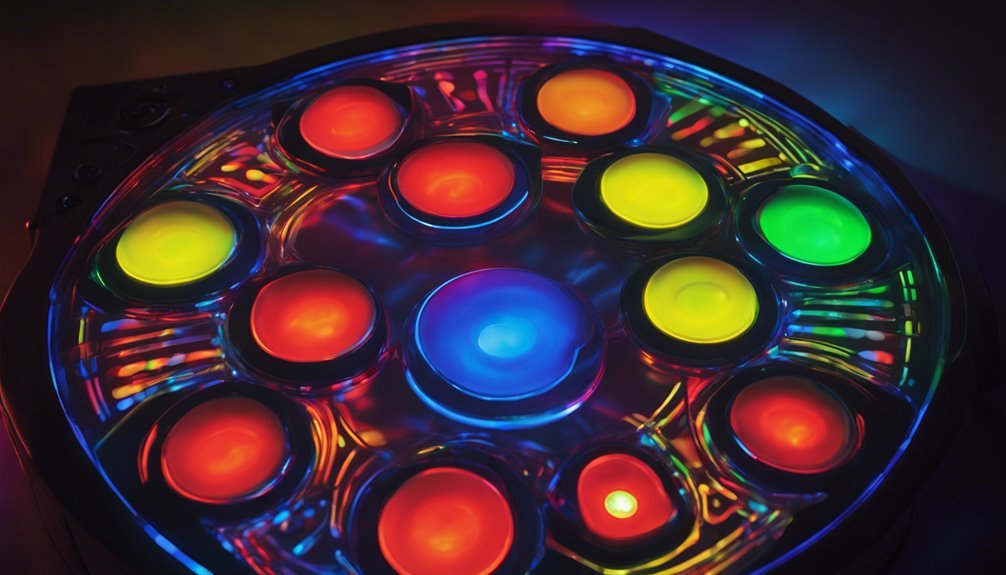Imagine you’re gathering with friends, and someone suggests playing Simon Says. You recall the simple rules: follow the commands only if they start with “Simon says.” But have you ever thought about why it’s still so popular or how it can be more than just a game? As you ponder its potential to improve skills like listening and memory, you might wonder if there’s more to this age-old game than meets the eye. Could it be a learning tool or a bridge between different cultures? Let’s explore the unexpected layers of Simon Says.
Key Takeaways
- Simon Says is a classic game that enhances listening skills. Players must follow commands only when they are prefixed by “Simon Says.”
- The game boosts short-term memory, concentration, and reaction time through interactive and engaging commands.
- Cultural variants, such as “Yakup der ki,” and themed versions, like “Santa Says,” offer diverse gameplay experiences.
- Electronic adaptations, including apps, expand accessibility while retaining the game’s core mechanics.
- User feedback, which averages 4.6 out of 5 stars, highlights its family appeal, cognitive benefits, and nostalgic value.
Understanding Simon Says

The Simon Says game is a classic childhood activity that sharpens your listening skills and attention. As you play, you’ll discover that Simon Says isn’t just about having fun; it’s a great exercise in memory and recall. The primary rule you must obey is to follow only those commands that begin with “Simon says.” This requirement forces you to focus intently, filtering out distractions and honing your ability to remember the sequence of instructions given.
In a typical game, players gather excitedly, ready to test their ability to differentiate between commands. If you act on a command that doesn’t start with “Simon says,” you’re out. This creates a thrilling challenge that demands concentration and quick thinking. As the game progresses, commands can become more complex, requiring you to recall previous instructions and adapt to new ones.
Simon Says is perfect for all ages and suitable for family gatherings or parties. With the game’s emphasis on listening rather than physical prowess, everyone can participate. Whether you’re three or thirty, understanding and mastering the art of Simon Says will keep you engaged while enhancing your mental agility and focus.
Cultural Variations
Around the world, Simon Says takes on various cultural flavors while retaining its core gameplay. When playing Simon in Turkey, you might hear “Yakup der ki,” reflecting the local language and traditions. This variation showcases how cultural nuances are woven into the fabric of this simple yet engaging game.
In Lebanon, the game transforms into “قال المعلّم,” which translates to “The teacher says. ” This tweak emphasizes the authority figure‘s role in leading the commands, highlighting the cultural importance of respecting elders or figures of authority.
In Spanish-speaking countries, the game often becomes “Mando,” meaning “I say.” This linguistic twist adds a personal touch to the commands, making the leader’s role more direct and engaging. Despite these cultural variations, the essence of playing Simon remains unchanged.
The core mechanics still revolve around discerning which commands to follow and which to ignore, creating a universal appeal that transcends language and cultural barriers. These adaptations illustrate Simon’s ability to resonate with diverse audiences, ensuring its enduring global popularity worldwide.
Whether it’s “Yakup der ki” or “قال المعلّم,” playing, Simon unites people through shared experiences and playful interactions.
How to Play

Kicking off a game of Simon Says requires selecting one player to take on the role of “Simon.” This player is in charge of issuing commands, but there’s a catch: only the commands prefixed with “Simon says” should be followed.
Your focus is essential as you participate. If Simon says, “Simon says touch your nose,” you should. However, you must remain still if Simon says, “Touch your nose” without the prefix. Failing to do so or incorrectly following commands will result in elimination from the game.
The excitement builds as Simon delivers more intricate and rapid-fire commands. Your listening skills and attention to detail are put to the test. One player stands out by being attentive and cautious, avoiding the traps set by Simon’s deceptive orders.
If you are the last player standing after all others have been eliminated, you win, and you earn the privilege of being the next Simon. This keeps the game fresh and engaging, ensuring everyone can lead and challenge their friends.
Gameplay Strategies
When playing Simon Says, mastering gameplay strategies is key to staying in the game. Focus on the command phrasing; if “Simon says” doesn’t start a command, resist the urge to act. This classic child’s play is all about listening closely.
Pay attention to Simon’s tone and body language, which might reveal whether a command is valid. Sometimes, Simon might try to trick you with subtle shifts in voice or gestures, so stay alert.
Quick reflexes and attentive listening are your best allies when you play Simon. As the game progresses, commands often get more complex and faster. Practice reacting quickly and staying calm under pressure.
Use tricks like associating commands with visual cues or specific movements to improve your memory during the game. This can help you recall instructions more easily and execute them with confidence.
Anticipate tricky commands from Simon. They might seem unrelated or counterintuitive, designed to catch you off guard. Imagining scenarios where Simon might deviate from the norm can prepare you better.
Popular Game Variants

When exploring popular variants of the Simon Says game, you’ll encounter the Electronic Simon version, which pushes your memory skills with complex sequences of colors or sounds.
You can also find adaptations from different cultures that add unique twists to the traditional gameplay.
Embrace these unique game mechanics to keep the experience fresh and engaging for everyone involved.
Electronic Simon Version
The Electronic Simon stands out as a timeless classic among the many popular game variants. First introduced in the late 1970s, this handheld memory game challenges you to repeat increasingly complex sequences of colors and sounds. As each successful round adds another color to the sequence, your short-term memory and reaction time are put to the test.
Its perfect blend of simplicity and challenge keeps players returning for more, making it a staple in classic and new game collections.
The modern version of Electronic Simon has evolved, featuring touch-sensitive buttons instead of the original physical ones. This update provides a more responsive and engaging gameplay experience. An LCD counter now tracks scores, adding a competitive edge that heightens the excitement and keeps players aiming for better performance with each attempt.
Electronic Simon’s influence has extended beyond its physical form, inspiring adaptations like mobile apps and online versions. These digital iterations guarantee its continued popularity across different age groups, allowing anyone to enjoy the thrill of this classic game anytime, anywhere.
It’s a reflection of the game’s enduring appeal and adaptability.
Cultural Adaptations Worldwide
Games often transcend borders, and the Simon Says game is no exception, morphing into unique cultural variants around the globe. In Turkey, you’ll find “Yakup der ki,” where Jacob replaces Simon, showcasing the cultural significance of how names and commands adapt to local contexts. The linguistic variation here reflects how deeply ingrained cultural nuances are in language.
Similarly, in Lebanon, the game becomes “قال المعلّم” (The teacher says), illustrating a shift in authority and social context, as the figure of a teacher carries a different weight in their community engagement.
In Spanish-speaking countries, the game is renamed “Mando,” which means “I say.” This shift emphasizes the role of direct communication in these cultures, where linguistic variations influence the game’s terminology.
Across the globe, these adaptations maintain the core mechanics of reacting to specific phrases, while local commands often resonate with cultural practices, such as seasonal celebrations or community events. These variations provide a unique insight into how communities infuse their values and traditions into a universally loved game, enriching the experience and engagement for all involved.
This global tapestry of play highlights the game’s enduring universal appeal.
Unique Game Mechanics
As the Simon Says game adapts culturally worldwide, it also evolves through unique mechanics, offering fresh challenges and experiences. These game adaptations maintain the core of Simon Says while introducing rule variations that boost player engagement.
One popular variant, Electronic Simon, invites you to engage with technology by repeating sequences of colors and sounds. This modern twist enhances memory and cognitive skills and keeps you hooked with its escalating complexity.
In “Do This, Do That,” commands specify which actions to follow and which to ignore, adding a new layer of complexity. This rule variation requires sharp attention, guaranteeing players stay on their toes.
The “Bird Fly” variant creatively incorporates thematic elements by challenging you to perform actions based on the perceived flying ability of different subjects. It adds an imaginative twist while keeping the core gameplay intact.
“Following John” removes verbal commands, pushing you to rely solely on silent observation. This game adaptation tests your attentiveness and ability to mimic actions without spoken instructions.
Each variant guarantees that the timeless game of Simon Says continues to captivate players of all ages.
Cognitive Benefits
When you play, Simon Says, you’re not just having fun but boosting your brainpower.
The game enhances short-term memory retention as you remember and follow varying commands while sharpening your quick thinking and reaction time.
These cognitive benefits make Simon Says a valuable tool for improving attention and concentration, especially in educational settings.
Memory Retention Enhancement
Simon Says isn’t just a playful pastime; it’s a powerful tool for enhancing short-term memory retention. When you play, you engage in a cognitive training game that boosts memory recall techniques. This isn’t a simple task—remembering a sequence of commands requires focus and sharpens your attention span.
Each round demands that you accurately recall and execute specific instructions, tapping into various brain areas. This process strengthens your cognitive processing capabilities, making remembering and applying new information easier.
The game’s repetitive nature helps you recognize patterns, a key component in memory retention. By continuously practicing this skill, you’ll have fun and hone your ability to learn efficiently.
Simon Says offers a dynamic environment that promotes concentration and attention to detail. These skills are invaluable in academic settings, where the ability to focus and retain information can greatly enhance your performance.
Participating regularly in Simon Says doesn’t just make you better at the game; it enhances your cognitive toolkit. You’re developing essential skills supporting educational pursuits and everyday interactions, turning a simple game into a powerful memory enhancement strategy.
Quick Thinking Development
While engaging in a game of Simon Says, you’re not just following commands—you’re honing your quick-thinking skills. The game challenges you to rapidly interpret and respond to commands, employing quick response techniques. This cognitive challenge exercise requires you to think on your feet and make decisions swiftly. As you distinguish between valid commands and distractions, you’re practicing decision-making, which boosts your attentional control and concentration.
Simon Says it is more than just a fun activity. It engages multiple brain regions that are responsible for processing auditory information and motor responses. This fosters cognitive flexibility, allowing you to adapt quickly to changing commands. This adaptability is essential for developing better decision-making under pressure.
Here’s how different elements of Simon Says contribute to quick thinking development:
| Element | Benefit | Skill Enhanced |
|---|---|---|
| Rapid Command Processing | Quick response techniques | Decision-making practice |
| Auditory-Motor Engagement | Cognitive challenge exercises | Cognitive flexibility |
| Command Differentiation | Attentional control | Concentration skills |
Regularly playing Simon Says can also improve your short-term memory as you remember and execute commands. Ultimately, this dynamic activity encourages you to think quickly, providing cognitive benefits beyond the game.
Reaction Time Improvement
Playing Simon Says can greatly boost your reaction time, making you a faster and more efficient responder in various situations. This game isn’t just child’s play; it’s a powerful tool for enhancing your reaction speed and reflex training.
Your cognitive agility gets a workout as you listen carefully and observe movements. Engaging both your auditory and visual processing skills fosters faster cognitive responses.
Here’s why you should consider incorporating Simon Says into your routine:
- Quick Decision-Making: You must immediately determine which commands to follow, sharpening your ability to make rapid decisions.
- Enhanced Hand-Eye Coordination: Promptly responding to verbal cues with physical actions improves your coordination, making everyday tasks easier.
- Strengthened Neural Pathways: Regular playing can enhance neural pathways associated with speed and accuracy, helping your brain work more efficiently.
- Increased Alertness: The game’s competitive nature keeps you on your toes, ready to react to any change, fostering heightened awareness.
These benefits translate into real-world advantages, where your enhanced reaction speed and cognitive agility can improve everything from driving to sports and even emergencies.
Embrace Simon Says, and watch your reflexes transform!
Electronic Simon Version

In today’s digital age, the Electronic Simon version revitalizes the classic game by challenging you to repeat complex sequences of colors and sounds, enhancing memory and cognitive skills. With its touch-sensitive buttons, the game offers electronic features that heighten user engagement. Each light tap on these buttons provides a more interactive experience than the original, making gameplay exciting and immersive.
Gameplay enhancements, such as the new LCD counter, keep track of your scores. At the same time, updated sounds,, such as victory dances and cheers,, boost the excitement, offering a contemporary twist to the nostalgic game.
This version is designed for ages seven and up and is perfect for solo play or with friends and family. Whether you’re at home or a family gathering, the game’s versatility guarantees everyone can join in on the fun.
Weighing only 1.28 ounces and measuring 9 x 2 x 9 inches, its portability means you can easily take it wherever you go. Storing it’s a breeze, so it’s always ready for spontaneous play.
The Electronic Simon version entertains and educates, making it ideal for leisure and learning environments.
Thematic Game Ideas
Consider injecting fresh energy with creative command variations and seasonal themes when planning a Simon Says game.
Imagine the fun of “Santa Says” during the holidays or “Pirate Captain Says” at a summer party, sparking excitement with themed commands like “Hoist the sails!”
Tailor the game to the occasion and watch players become more engaged and enthusiastic.
Creative Command Variations
Introducing thematic variations can transform the playful chaos of a Simon Says game into a delightful journey of imagination and fun. By crafting themed commands, you can infuse the game with festive variations that capture the spirit of any occasion.
Imagine the joy on children’s faces when a “Superhero” commands them to fly like their favorite hero or the laughter that ensues when a “Pirate Captain” has them searching for imaginary treasure. These imaginative engagements keep players entertained and encourage creativity and active participation.
To spark excitement in your next Simon Says game, try these creative command variations:
- Holiday Delight: To add a festive twist to parties, say “Santa says” for Christmas or “Birthday King says.”
- Character Fun: Incorporate beloved characters like “Superhero says,” sparking children’s imagination and energy.
- Cultural Engagement: Include cultural references with “Olympian says” to promote teamwork and community spirit.
- Seasonal Flair: Avoid seasonal themes, focusing instead on other thematic variations that enhance engagement without relying on the time of year.
Seasonal Simon Themes
There’s nothing like a themed Simon Says game to bring an extra layer of excitement to any occasion. Imagine transforming the classic game into festive variations that match seasons and celebrations.
“Santa Says” can lead you to make a snow angel or sing a carol during Christmas, perfectly capturing the holiday spirit with themed commands. It’s a delightful way to infuse joy into your gatherings.
For Halloween, switch things up with “The Pumpkin Says,” where you might pretend to carve a pumpkin or dance like a ghost. These playful adaptations add a spooky twist, making it a hit at any Halloween party.
Summer offers the “Beach Buddy says” version, where commands like “build a sandcastle” or “splash like a wave” bring the beach vibe to life.
Are you celebrating a birthday? “Birthday Boy/Girl lets you blow out candles or open a present, adding a personal and joyful touch.
Remember cultural events like “New Year’s Eve,” where countdowns and dance moves elevate the fun.
With these seasonal themes, you can create a vibrant and engaging Simon Says game that resonates with every occasion.
Simon Says in Education

Within educational settings, Simon Says is a powerful tool for enhancing students’ listening skills and ability to follow directions accurately. This game develops listening skills through interactive learning strategies that captivate students’ attention.
It’s an excellent way to integrate classroom engagement techniques, turning an ordinary lesson into an exciting experience. Imagine the thrill as students listen intently, keen to catch every word before executing a command.
Incorporating Simon Says into your teaching arsenal can lead to remarkable outcomes:
- Boosts Engagement: Watch as students light up enthusiastically, hanging on to every word you say.
- Encourages Active Participation: Students move and respond, transforming passive learning into active involvement.
- Reinforces Academic Concepts: With commands like “Simon says spell your name,” you’re embedding lessons in a playful context.
- Foster’s Social Skills: As students take turns, they learn the importance of cooperation and respect.
User Feedback and Reviews
In user feedback and reviews, Simon Says consistently shines with its impressive average score of 4.6 out of 5 stars from over 4,162 ratings. This high rating reflects its widespread popularity and positive user experiences.
Many players find the game not just fun and addictive but also an excellent tool for enhancing memory and cognitive skills. It’s a hit across all age groups, appealing to toddlers, seniors, and everyone. Thanks to its engaging multiplayer dynamics, families enjoy it as a versatile entertainment option.
Nostalgic memories play a significant role in Simon Says’ enduring appeal. Many adult users fondly remember playing it during their childhood, adding familiarity and warmth to their current experiences. This nostalgia and the game’s ability to unite people reinforce its status as a timeless classic.
Some users, however, have noted that the new version’s sound can be rather loud. One practical tip shared among players is to cover the speaker holes to reduce the volume to more comfortable levels. This minor tweak enhances enjoyment without detracting from the game’s core appeal.
Frequently Asked Questions
How Do You Play the Simon Says Game?
To play, listen closely to commands. Use Simon Says strategies to avoid elimination. Explore Simon Says variations for added challenge. Benefits include improved listening skills and quicker reactions. Stay attentive; only follow commands starting with “Simon says” to win.
What Are the Actions for Simon Says Game?
You’re exploring action variations, where player roles shift based on creativity. Implement game strategies like speeding commands or mixing sequences. Use physical movements, creating challenges that test your active listening and quick reactions for an engaging experience.
How Is the Simon Game Played?
You play the Simon game by following specific commands and enhancing your listening skills. Explore variations of the Simon game for team-building or children’s activities. It’s a fun way to improve concentration and cooperation while enjoying different themes and challenges.
What to Say When You Are Playing Simon Says?
When leading, use engaging instructions like “jump three times” or playful phrases like “be a statue.” Use command examples like “touch your toes.” Mix in impossible tasks to keep everyone on their toes.
Conclusion
By diving into the world of Simon Says, you’ll discover an entertaining and educational game. Whether playing traditional versions or exploring cultural twists, you’ll enhance your listening skills and sharpen your focus. Try out different strategies and themes to keep everyone engaged and challenged. With its cognitive benefits, Simon Says is perfect for classrooms, family gatherings, or just a fun afternoon. Don’t wait—start playing and experience the joy and learning it brings!

